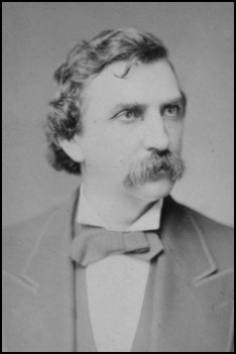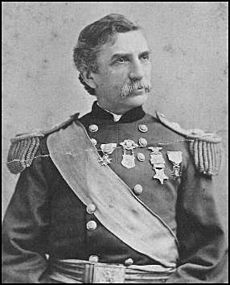John F. Hartranft facts for kids
Quick facts for kids
John F. Hartranft
|
|
|---|---|
 |
|
| 17th Governor of Pennsylvania | |
| In office January 21, 1873 – January 21, 1879 |
|
| Lieutenant | John Latta |
| Preceded by | John W. Geary |
| Succeeded by | Henry M. Hoyt |
| Pennsylvania Auditor General | |
| In office 1866–1872 |
|
| Governor | Andrew Gregg Curtin John W. Geary |
| Preceded by | Isaac Slenker |
| Succeeded by | Harrison Allen |
| Personal details | |
| Born |
John Frederick Hartranft
December 16, 1830 New Hanover Township, Montgomery County, Pennsylvania |
| Died | October 17, 1889 (aged 58) Norristown, Pennsylvania |
| Resting place | Montgomery Cemetery (West Norriton Township, Pennsylvania) |
| Political party | Republican |
| Spouse | Sallie Douglas Sebring |
| Profession | Lawyer |
| Awards | Medal of Honor |
| Signature | |
| Military service | |
| Allegiance | United States Union |
| Branch/service | United States Army Union Army |
| Years of service | 1861–1865 |
| Rank | |
| Unit | |
| Battles/wars | American Civil War: |
John Frederick Hartranft (December 16, 1830 – October 17, 1889) was an important United States military officer and politician. He became a major general in the Union Army during the American Civil War. For his bravery, he was awarded the U.S. Medal of Honor.
After the war, he served as the 17th Governor of Pennsylvania from 1873 to 1879.
Contents
Early Life and Education
John Hartranft was born in Fagleysville, a small village in New Hanover Township, Montgomery County, Pennsylvania. His parents were Mary Lydia (Bucher) and Samuel Engle Hartranft, who were of German descent.
As a boy, his family moved to Norristown. He went to Marshall College in Mercersburg. Later, he finished his degree in civil engineering in 1853 from Union College in Schenectady.
After college, he worked briefly for two railroad companies. He then returned home to Norristown to help his father with his real estate and stagecoach businesses. In 1854, he became a deputy sheriff for Montgomery County, Pennsylvania. That same year, he married Sallie Douglas Sebring. They had six children, but sadly, three of them died when they were babies.
Hartranft was also active in his local fire company and a Freemason lodge. He studied law and became a lawyer in 1860. He also joined the Pennsylvania Militia, where he was promoted to colonel.
Civil War Service
In April 1861, when the Civil War began, Hartranft quickly gathered a group of volunteers from Montgomery County. He became the colonel of the 4th Pennsylvania Volunteer Infantry. Their enlistment was for 90 days.
Just as their term ended, the First Battle of Bull Run was about to begin. Even though his regiment decided to go home, Hartranft chose to stay and fight with the Army. This brave act earned him the Medal of Honor on August 21, 1886. He helped rally confused regiments during the battle.
Hartranft then formed a new regiment, the 51st Pennsylvania Infantry, which served for three years. He became their colonel. They first fought along the North Carolina coast in the Burnside Expedition. Hartranft led them in battles at Roanoke Island and New Bern.
In July 1862, his men joined the IX Corps. They fought in the Second Battle of Bull Run and at South Mountain. They also took part in the Battle of Antietam. There, Hartranft led a famous charge across Burnside's Bridge, where his unit suffered many casualties. They also fought at the Battle of Fredericksburg.
The 51st Pennsylvania later moved to the Western Theater. Hartranft saw action at the Siege of Vicksburg, Campbell's Station, and Knoxville. In the last two battles, he commanded the 2nd Division of the IX Corps, even though he was still a colonel.
In 1864, he commanded a brigade in the Overland Campaign. He fought in battles like the Wilderness and Spotsylvania. He was promoted to brigadier general on May 12, 1864. He continued to lead his troops in operations near Richmond and Petersburg. His brigade showed great courage at the Battle of Peebles' Farm.
When the IX Corps was reorganized, Hartranft was given command of a new division. He was promoted to brevet major general by Lt. Gen. Ulysses S. Grant. This was for his actions in defeating Confederate General Robert E. Lee's last major attack at the Battle of Fort Stedman. He led his division to counterattack and recapture the fort.
Post-War Life and Political Career
After the war, John Hartranft joined the Republican Party. He served as the Auditor General of Pennsylvania from 1867 to 1873.
In 1872, Hartranft was elected as the Governor of Pennsylvania. As governor, he strongly supported education and improving cities. He also worked to regulate banking and boost industry. He reorganized the National Guard. He believed in voting rights for African Americans and fought against political corruption. He also stood up for the rights of working people.
During his time as governor, Pennsylvania's constitution was updated and approved in 1873. This new constitution made important changes. For example, it increased the terms for state lawmakers. House terms went from one year to two, and Senate terms from three years to four.
In 1876, he became a member of the American Philosophical Society. He also served as the 5th commander-in-chief of the Grand Army of the Republic. This was a large organization for Union Army veterans.
Pennsylvania played a big role in the Centennial Exposition in 1876. This national celebration marked 100 years since the United States was founded. The main events were held in Philadelphia's Fairmount Park.
At the Republican National Convention in June 1876, Hartranft was considered for president. However, Rutherford B. Hayes of Ohio was chosen instead. Hayes had served with Hartranft during the Civil War.
During his second term, the country faced economic challenges. There were low wages and unemployment. This led to widespread strikes and unrest among workers, especially during the Great Railroad Strike of 1877. Serious civil disturbances happened in cities like Philadelphia, Pittsburgh, Reading, and Scranton.
Governor Hartranft called out the state militia and then Regular Army troops to restore order. In some cities, fires were set, and railroad property was destroyed. After these events, Hartranft suggested that labor unions should be recognized. He also proposed using arbitration to settle worker disputes.
After his time as governor, Hartranft returned home in 1879. He became a US Postmaster. Later, he was appointed as the Port Collector for Philadelphia from 1881 to 1885. He also continued to command the Pennsylvania National Guard, which he had helped to build up.
On August 26, 1886, Hartranft was again recognized for his bravery. He was awarded the Medal of Honor for his actions during the First Battle of Bull Run in 1861.
John Hartranft passed away in Norristown on October 17, 1889. He was buried in Montgomery Cemetery near Norristown. The Pennsylvania National Guard later placed a tall stone monument, called an obelisk, on his grave.
In Memoriam
| Designations | |
|---|---|
|
Pennsylvania Historical Marker
|
|
| Official name | John F. Hartranft |
| Type | Roadside |
| Criteria | Civil War, Government & Politics, Government & Politics 19th Century, Governors, Military |
| Designated | May 6, 1947 |
| Location | Sanatoga Rd. & Cross Rd., SW of Fagleysville |
| Marker Text | The birthplace of John F. Hartranft, Civil War hero and Pennsylvania Governor, 1873-79, is to the right on the side road. He reorganized the State Militia as part of the National Guard. |

Many places and groups honor John F. Hartranft. An equestrian statue, showing him on horseback, stands next to the Pennsylvania Capitol Building in Harrisburg. Camp No. 15 of the Sons of Union Veterans of the Civil War is named after him.
Marble monuments at Petersburg and Vicksburg also honor his service during the Civil War. An elementary school in Norristown and another in Philadelphia are named for him.
The Hartranft section of North Philadelphia is named in his honor. A street in the Packer Park section of South Philadelphia, near the sports complex, also bears his name. A residence hall at the University Park campus of Pennsylvania State University is named after him.
Three avenues in Montgomery County, Pennsylvania are named for him. One is in Norristown, Pennsylvania, leading to the cemetery where he is buried. The others are in nearby East Norriton Township and Fort Washington. A street in the Brookline section of Pittsburgh, Pennsylvania is also named after him.
Starting in 1899, a "General Hartranft" cigar brand was made by C. E. Blair and Sons of Harrisburg.
Images for kids


